remote start CITROEN DISPATCH SPACETOURER 2020 Handbook (in English)
[x] Cancel search | Manufacturer: CITROEN, Model Year: 2020, Model line: DISPATCH SPACETOURER, Model: CITROEN DISPATCH SPACETOURER 2020Pages: 324, PDF Size: 10.89 MB
Page 139 of 324

137
F Press this button again ; its indicator
remains off for as long as the child lock
is deactivated. A message confirms the
deactivation.
In the event of a serious impact, the
electric child lock is deactivated (child lock
off) automatically.
Any other state of the indicator lamp
indicates a fault with the electric child lock.
Have it checked by a CITROËN dealer or
a qualified workshop.
This system is independent and in no
circumstances does it take the place of
the central locking control.
Do not drive with the sliding side door
open.
Check the status of the child lock each
time you switch on the ignition.
Always remove the key from the ignition
when leaving the vehicle, even for a short
time.Child lock on rear
windows
This mechanical system prevents
opening of the left and/or right rear
side windows.
F
L
ock /unlock the system using the remote
control key or the back-up key of the
Keyless Entry and Starting system.
5
Safety
Page 142 of 324

140
If this warning lamp and the STOP
warning lamp come on, stop the
vehicle and switch off the engine as
soon as possible.
Brakes
Braking distances are increased when towing a
trailer. To avoid overheating of the brakes, the
use of engine braking is recommended.
Side wind
Bear in mind the increased sensitivity to wind
that your vehicle will have.
Anti-theft protection
Electronic immobiliser
The remote control contains an electronic chip
which has a special code. When the ignition is
switched on, this code must be recognised in
order for starting to be possible.
A few seconds after switching off the ignition,
this system locks the engine control system,
therefore preventing the engine from being
started in the event of a break-in.
In the event of a fault, you are
informed by illumination of this
warning lamp, an audible signal and
a message on the screen. The vehicle will not start
; contact a CITROËN
dealer as soon as possible.
Starting/switching off the
engine
Starting
The parking brake must be applied.
F
W
ith a manual gearbox , place the gear
lever in the neutral position, fully depress
the clutch pedal and keep the pedal down
until the engine starts.
F
W
ith an automatic gearbox , place the
selector in position P then fully depress the
brake pedal.
F
W
ith an electronic gearbox , place the
selector in position N then fully depress the
brake pedal.
With the conventional key/With
the remote control key
1. Stop position.
2. Ignition on position.
3. Starting position.
F
I
nsert the key into the ignition switch. The
system recognises the starting code.
F
U
nlock the steering column by
simultaneously turning the steering wheel
and the key.
In certain circumstances, a significant
effort may be required to turn the steering
wheel (if the wheels are against a kerb, for
example).
F
T
urn the key to position 2, ignition on, to
operate the engine preheating system.
F
W
ait until this warning lamp
goes off in the instrument panel,
then operate the starter motor
by turning the key to position
3
without pressing the accelerator
pedal, until the engine starts.
Once the engine starts, release
t h e key.
Driving
Page 143 of 324
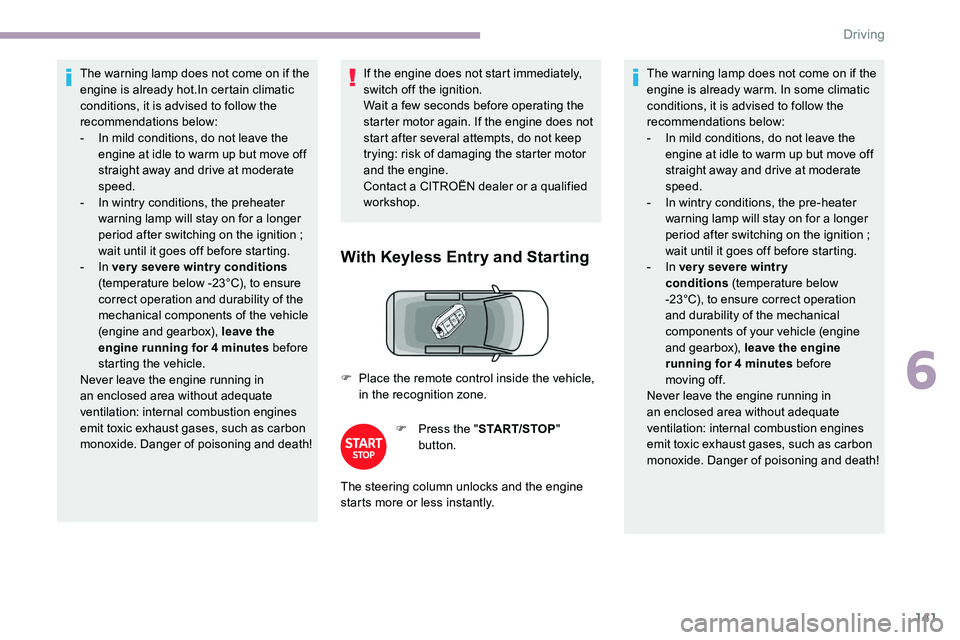
141
The warning lamp does not come on if the
engine is already hot.In certain climatic
conditions, it is advised to follow the
recommendations below:
-
I
n mild conditions, do not leave the
engine at idle to warm up but move off
straight away and drive at moderate
speed.
-
I
n wintry conditions, the preheater
warning lamp will stay on for a longer
period after switching on the ignition
;
wait until it goes off before starting.
-
In very severe wintry conditions
(temperature below -23°C), to ensure
correct operation and durability of the
mechanical components of the vehicle
(engine and gearbox), leave the
engine running for 4
minutes before
starting the vehicle.
Never leave the engine running in
an enclosed area without adequate
ventilation: internal combustion engines
emit toxic exhaust gases, such as carbon
monoxide. Danger of poisoning and death! If the engine does not start immediately,
switch off the ignition.
Wait a few seconds before operating the
starter motor again. If the engine does not
start after several attempts, do not keep
trying: risk of damaging the starter motor
and the engine.
Contact a CITROËN dealer or a qualified
workshop.
With Keyless Entry and Starting
F Press the "
START/STOP"
button. The warning lamp does not come on if the
engine is already warm. In some climatic
conditions, it is advised to follow the
recommendations below:
-
I
n mild conditions, do not leave the
engine at idle to warm up but move off
straight away and drive at moderate
speed.
-
I
n wintry conditions, the pre-heater
warning lamp will stay on for a longer
period after switching on the ignition ;
wait until it goes off before starting.
- In
ver y severe wintr y
conditions
(temperature below
-23°C), to ensure correct operation
and durability of the mechanical
components of your vehicle (engine
and gearbox), leave the engine
running for 4
minutes
before
moving off.
Never leave the engine running in
an enclosed area without adequate
ventilation: internal combustion engines
emit toxic exhaust gases, such as carbon
monoxide. Danger of poisoning and death!
F
P
lace the remote control inside the vehicle,
in the recognition zone.
The steering column unlocks and the engine
starts more or less instantly.
6
Driving
Page 144 of 324
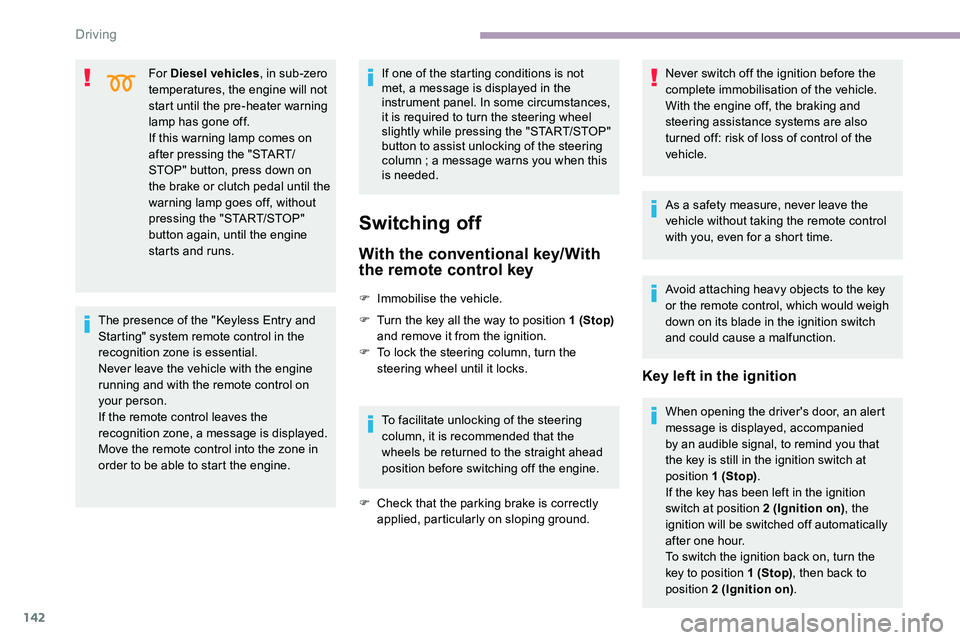
142
For Diesel vehicles, in sub-zero
temperatures, the engine will not
start until the pre-heater warning
lamp has gone off.
If this warning lamp comes on
after pressing the "START/
STOP" button, press down on
the brake or clutch pedal until the
warning lamp goes off, without
pressing the "START/STOP"
button again, until the engine
starts and runs.
The presence of the "Keyless Entry and
Starting" system remote control in the
recognition zone is essential.
Never leave the vehicle with the engine
running and with the remote control on
your person.
If the remote control leaves the
recognition zone, a message is displayed.
Move the remote control into the zone in
order to be able to start the engine. If one of the starting conditions is not
met, a message is displayed in the
instrument panel. In some circumstances,
it is required to turn the steering wheel
slightly while pressing the "START/STOP"
button to assist unlocking of the steering
column
; a message warns you when this
is needed.
Switching off
With the conventional key/With
the remote control key
F Immobilise the vehicle.
F
T
urn the key all the way to position 1 (Stop)
and remove it from the ignition.
F
T
o lock the steering column, turn the
steering wheel until it locks.
To facilitate unlocking of the steering
column, it is recommended that the
wheels be returned to the straight ahead
position before switching off the engine.
F
C
heck that the parking brake is correctly
applied, particularly on sloping ground. Never switch off the ignition before the
complete immobilisation of the vehicle.
With the engine off, the braking and
steering assistance systems are also
turned off: risk of loss of control of the
vehicle.
As a safety measure, never leave the
vehicle without taking the remote control
with you, even for a short time.
Avoid attaching heavy objects to the key
or the remote control, which would weigh
down on its blade in the ignition switch
and could cause a malfunction.
Key left in the ignition
When opening the driver's door, an alert
message is displayed, accompanied
by an audible signal, to remind you that
the key is still in the ignition switch at
position
1
(Stop).
If the key has been left in the ignition
switch at position 2 (Ignition on) , the
ignition will be switched off automatically
after one hour.
To switch the ignition back on, turn the
key to position 1 (Stop) , then back to
position
2 (Ignition on) .
Driving
Page 145 of 324

143
With Keyless Entry and Starting
F Immobilise the vehicle.
F
W
ith the remote control in the recognition
zone, press the " START/STOP" button.
The engine stops and the steering column
locks. If the vehicle is not immobilised, the
engine will not stop.
To avoid any risk of jamming the pedals:
-
o
nly use mats which are suited to the
fixings already present in the vehicle
;
these fixings must be used,
-
n
ever place one mat on top of another.
The use of mats not approved by
CITROËN may inter fere with access to
the pedals and hinder the operation of the
cruise control
/ speed limiter.
The mats approved by CITROËN have two
fixings located below the seat.
Special case with Keyless
Entry and Starting
Switching the ignition on without
starting
With the Keyless Entry and Starting
electronic key inside the vehicle,
pressing the " START/STOP " button,
without pressing any of the
pedals , allows the ignition to be
switched on.
F
P
ress this button again to switch off the
ignition and allow the vehicle to be locked.
Back-up starting
Should your vehicle not detect the electronic
key in the recognition zone, because the
remote control battery is flat, a back-up reader
is provided to the left behind the steering
wheel, to allow starting.
F
W
ith a manual gearbox , place the gear
lever in the neutral position, fully depress
the clutch pedal and keep the pedal down
until the engine starts. F
W
ith an automatic gearbox
, place the
selector in position P then fully depress the
brake pedal.
F
W
ith an electronic gearbox
, place the
selector in position N then fully depress the
brake pedal.
F
T
hen press the "
START/STOP" button.
The engine starts.
Remote control not recognised
If the remote control is no longer in the
recognition zone, a message appears in the
instrument panel when closing a door or trying
to switch off the engine.
F
T
o confirm switching off the engine, press
and hold the " START/STOP " button for
about 3
seconds, then contact a CITROËN
dealer or a qualified workshop.
Forced switch-off
In the event of an emergency only and with
the vehicle stationary, you can switch off the
engine.
F
T
o do this, press the “ S TA R T/
STOP ” button for about 3
seconds.
In this case, the steering column locks as soon
as the vehicle stops.
F
P
lace and hold the remote control against
the reader, then:
6
Driving
Page 150 of 324
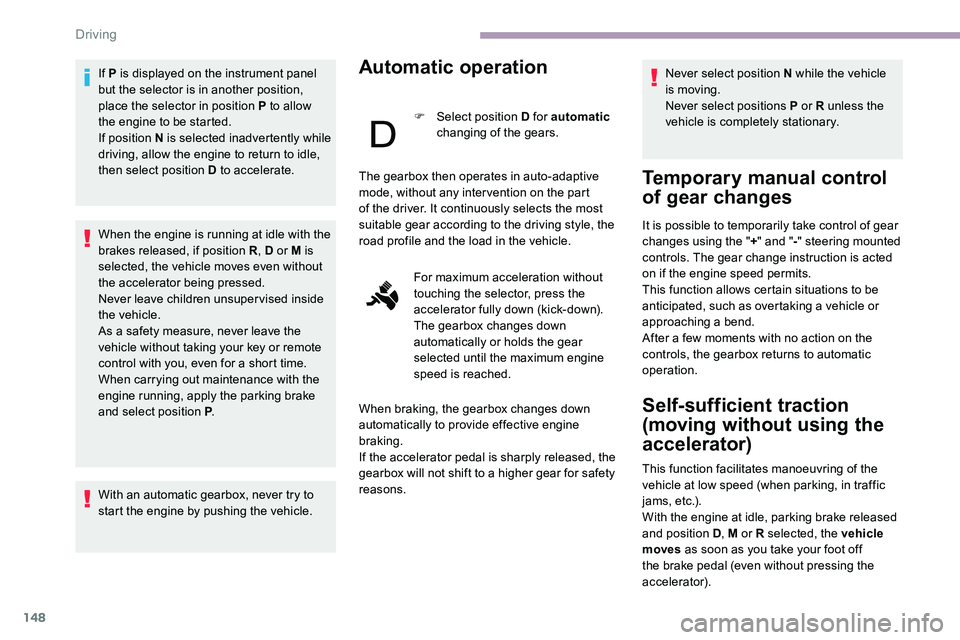
148
If P is displayed on the instrument panel
but the selector is in another position,
place the selector in position P to allow
the engine to be started.
If position N is selected inadvertently while
driving, allow the engine to return to idle,
then select position D to accelerate.
When the engine is running at idle with the
brakes released, if position R, D or M is
selected, the vehicle moves even without
the accelerator being pressed.
Never leave children unsuper vised inside
the vehicle.
As a safety measure, never leave the
vehicle without taking your key or remote
control with you, even for a short time.
When carrying out maintenance with the
engine running, apply the parking brake
and select position P .
With an automatic gearbox, never try to
start the engine by pushing the vehicle.Automatic operation
F Select position D for automatic
changing of the gears. Never select position N while the vehicle
is moving.
Never select positions P or R unless the
vehicle is completely stationary.
Temporary manual control
of gear changes
It is possible to temporarily take control of gear
changes using the "
+" and " -" steering mounted
controls. The gear change instruction is acted
on if the engine speed permits.
This function allows certain situations to be
anticipated, such as overtaking a vehicle or
approaching a bend.
After a few moments with no action on the
controls, the gearbox returns to automatic
operation.
Self-sufficient traction
(moving without using the
accelerator)
This function facilitates manoeuvring of the
vehicle at low speed (when parking, in traffic
jams, etc.).
With the engine at idle, parking brake released
and position D , M or R selected, the vehicle
moves
as soon as you take your foot off
the brake pedal (even without pressing the
accelerator).
The gearbox then operates in auto-adaptive
mode, without any inter vention on the part
of the driver. It continuously selects the most
suitable gear according to the driving style, the
road profile and the load in the vehicle.
For maximum acceleration without
touching the selector, press the
accelerator fully down (kick-down).
The gearbox changes down
automatically or holds the gear
selected until the maximum engine
speed is reached.
When braking, the gearbox changes down
automatically to provide effective engine
braking.
If the accelerator pedal is sharply released, the
gearbox will not shift to a higher gear for safety
reasons.
Driving
Page 221 of 324
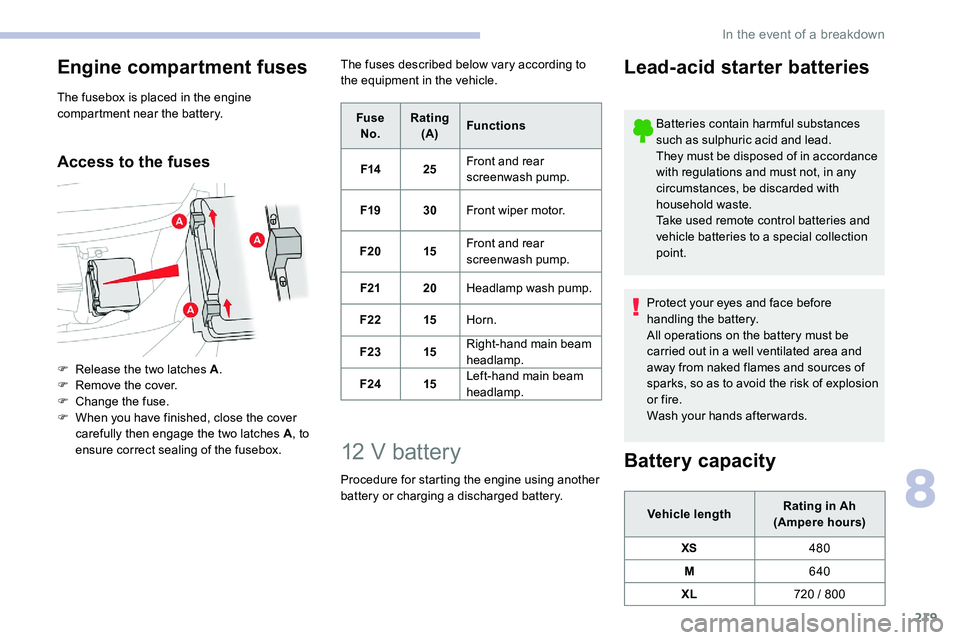
219
Engine compartment fuses
The fusebox is placed in the engine
compartment near the battery.
Access to the fuses
F Release the two latches A.
F R emove the cover.
F
C
hange the fuse.
F
W
hen you have finished, close the cover
carefully then engage the two latches A , to
ensure correct sealing of the fusebox. The fuses described below vary according to
the equipment in the vehicle.
FuseNo. Rating
(A) Functions
F14 25Front and rear
screenwash pump.
F19 30Front wiper motor.
F20 15Front and rear
screenwash pump.
F21 20Headlamp wash pump.
F22 15Horn.
F23 15Right-hand main beam
headlamp.
F24 15Left-hand main beam
headlamp.
12
V battery
Procedure for starting the engine using another
battery or charging a discharged battery.
Lead-acid starter batteries
Batteries contain harmful substances
such as sulphuric acid and lead.
They must be disposed of in accordance
with regulations and must not, in any
circumstances, be discarded with
household waste.
Take used remote control batteries and
vehicle batteries to a special collection
point.
Protect your eyes and face before
handling the battery.
All operations on the battery must be
carried out in a well ventilated area and
away from naked flames and sources of
sparks, so as to avoid the risk of explosion
or fire.
Wash your hands afterwards.
Battery capacity
Vehicle length Rating in Ah
(Ampere hours)
XS 480
M 640
XL 720
/ 800
8
In the event of a breakdown
Page 222 of 324

220
The battery is located under the bonnet.
F O pen the bonnet using the interior release
lever, then the exterior safety catch.
F
S
ecure the bonnet stay.
For more information on the Bonnet and
the Engine , refer to the corresponding
sections.
Starting using another
battery
When your vehicle's battery is discharged, the
engine can be started using a backup battery
(external or from another vehicle) and jump
leads or using a battery booster.
Never start the engine by connecting a
battery charger.
Never use a 24
V or higher battery
b o o s t e r.
Check beforehand that the backup
battery has a nominal voltage of 12
V and
a capacity at least equal to that of the
discharged battery.
The two vehicles must not be in contact
with each other.
Switch off all the electrical consumers
on both vehicles (audio system, wipers,
lighting, etc.).
Make sure that the jump leads are not
close to the moving parts of the engine
(fan, belt, etc.).
Do not disconnect the (+) terminal while
the engine is running.
Always replace the battery with one of
equivalent specification.
Access to the battery
F Remove the plastic cover to access the (+)
terminal, if your vehicle has one.
The battery (-) terminal is not accessible.
A remote earth point is provided at the front of
the vehicle. F
L
ift the plastic cover on the (+) terminal, if
your vehicle has one.
F
C
onnect the red cable to the (+) terminal of
flat battery A (at the metal elbow), then to
the (+) terminal of backup battery B or the
b o o s t e r.
F
C
onnect one end of the green or black
cable to the (-) terminal of backup battery B
or the booster (or to an earth point on the
assisting vehicle).
F
C
onnect the other end of the green or black
cable to earth point C on the broken down
vehicle.
F
S
tart the engine of the assisting vehicle and
leave it running for a few
minutes.
F
O
perate the starter on the broken down
vehicle and let the engine run.
If the engine does not start straight away,
switch off the ignition and wait a few moments
before trying again.
In the event of a breakdown
Page 224 of 324
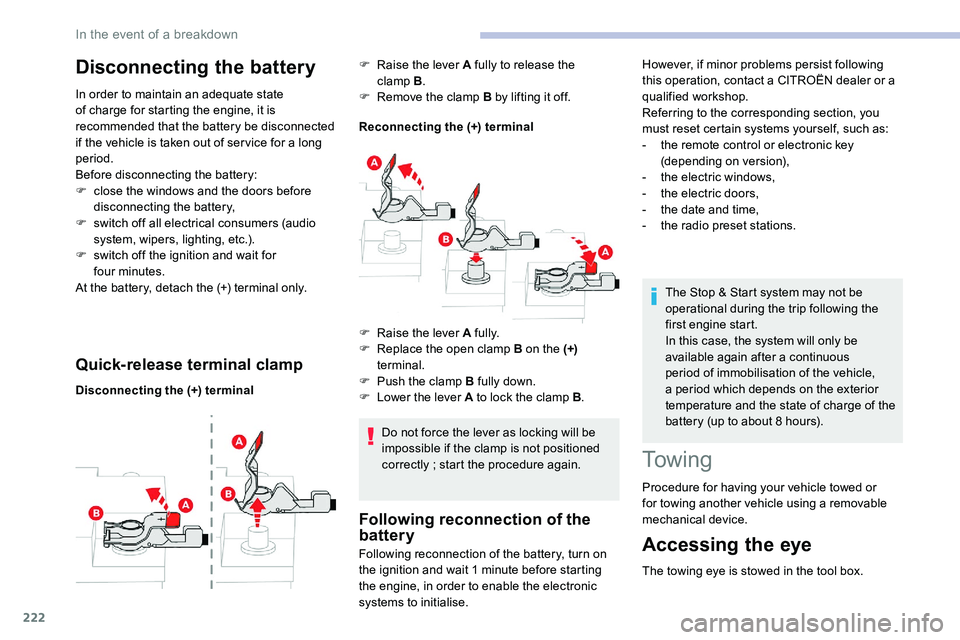
222
Disconnecting the battery
In order to maintain an adequate state
of charge for starting the engine, it is
recommended that the battery be disconnected
if the vehicle is taken out of ser vice for a long
period.
Before disconnecting the battery:
F
c
lose the windows and the doors before
disconnecting the battery,
F
s
witch off all electrical consumers (audio
system, wipers, lighting, etc.).
F
s
witch off the ignition and wait for
four
minutes.
At the battery, detach the (+) terminal only.
Quick-release terminal clamp
Disconnecting the (+) terminal Reconnecting the (+) terminal
Do not force the lever as locking will be
impossible if the clamp is not positioned
correctly ; start the procedure again.
Following reconnection of the
battery
F Raise the lever A fully to release the clamp B.
F
R
emove the clamp B by lifting it off.
Following reconnection of the battery, turn on
the ignition and wait 1
minute before starting
the engine, in order to enable the electronic
systems to initialise. The Stop & Start system may not be
operational during the trip following the
first engine start.
In this case, the system will only be
available again after a continuous
period of immobilisation of the vehicle,
a period which depends on the exterior
temperature and the state of charge of the
battery (up to about 8 hours).
To w i n g
Procedure for having your vehicle towed or
for towing another vehicle using a removable
mechanical device.
Accessing the eye
The towing eye is stowed in the tool box.
F
Ra
ise the lever A fully.
F
R
eplace the open clamp B on the (+)
terminal.
F
P
ush the clamp B fully down.
F
L
ower the lever A to lock the clamp B
.However, if minor problems persist following
this operation, contact a CITROËN dealer or a
qualified workshop.
Referring to the corresponding section, you
must reset certain systems yourself, such as:
-
t
he remote control or electronic key
(depending on version),
-
t
he electric windows,
-
t
he electric doors,
-
t
he date and time,
-
t
he radio preset stations.
In the event of a breakdown
Page 311 of 324
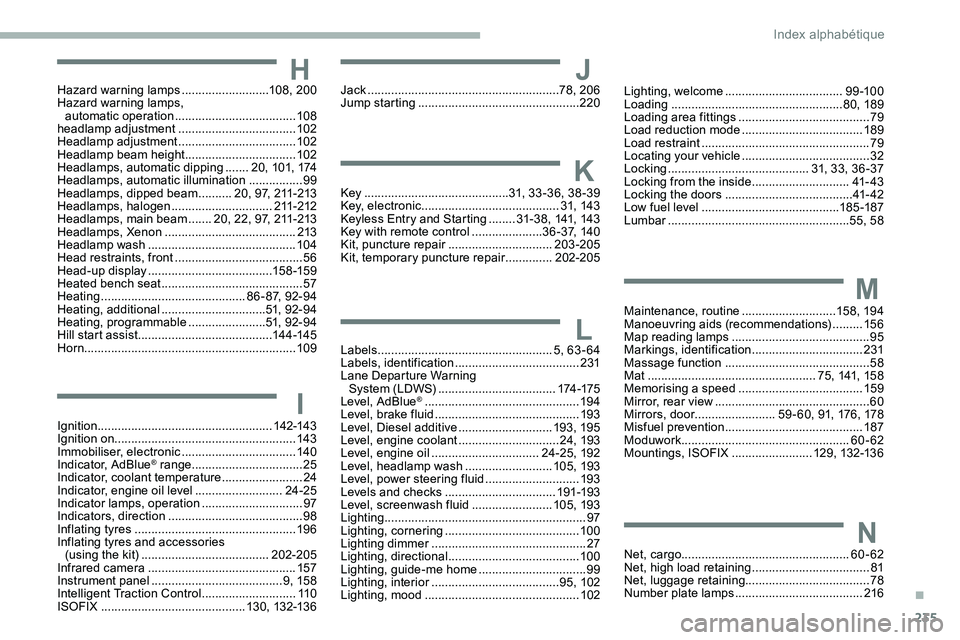
235
H
I
Hazard warning lamps ..........................108, 200
Hazard warning lamps, automatic operation
.................................... 10
8
headlamp adjustment
...................................102
Headlamp adjustment
...................................102
Headlamp beam height
................................. 10
2
Headlamps, automatic dipping
.......20, 101, 174
Headlamps, automatic illumination
................99
Headlamps, dipped beam
..........20, 97, 211-213
Headlamps, halogen
..............................211-212
Headlamps, main beam
.......20, 22, 97, 211-213
Headlamps, Xenon
....................................... 213
Headlamp wash
..............................
..............104
Head restraints, front
...................................... 56
Head-up display
..................................... 15
8 -159
Heated bench seat
.......................................... 57
Heating
........................................... 8
6 - 87, 92-94
Heating, additional
............................... 51, 9 2- 9 4
Heating, programmable
.......................51, 9 2- 9 4
Hill start assist
........................................ 14 4 -145
Horn ............................................................... 109
Ignition
................
.................................... 142-143
Ignition on ...................................................... 143
Immobiliser, electronic
..................................140
Indicator, AdBlue
® range ................................. 25
Indicator, coolant temperature ........................ 24
Indicator, engine oil level
.......................... 24-25
Indicator lamps, operation
.............................. 97
I
ndicators, direction
........................................ 98
Inflating tyres
................................................ 19 6
Inflating tyres and accessories (using the kit)
...................................... 202-205
Infrared camera
............................................ 157
Instrument panel
....................................... 9, 15 8
Intelligent Traction Control
............................ 11 0
ISOFIX
........................................... 13 0, 132-13 6
JJack .........................................................78, 206
Jump starting ................................................ 220
LLabels .................................................... 5, 63 - 64
Labels, identification ..................................... 231
Lane Departure Warning System (LDWS)
................................... 174 -175
Level, AdBlue
® .............................................. 19 4
Level, brake fluid ........................................... 193
Level, Diesel additive
............................ 193, 195
Level, engine coolant
.............................. 24, 193
Level, engine oil
................................ 24 -25, 192
Level, headlamp wash
.......................... 105, 193
Level, power steering fluid
............................ 193
Levels and checks
..............................
...191-193
Level, screenwash fluid
........................ 1
05, 193
Lighting
............................................................ 97
Lighting, cornering
........................................ 10 0
Lighting dimmer
.............................................. 27
Lighting, directional
....................................... 10 0
Lighting, guide-me home
................................ 99
Lighting, interior
...............................
.......95, 102
Lighting, mood
.............................................. 102
Key
...........................................
31, 33 -36, 38 -39
Key, electronic
.........................................
31, 14 3
Keyless Entry and Starting
........
3
1- 3 8, 141, 143
Key with remote control
.....................
3
6 - 3 7, 1 4 0
Kit, puncture repair
............................... 20
3-205
Kit, temporary puncture repair
.............. 202
-205
K
Lighting, welcome
................................... 9 9 -10 0
Loading ................................................... 8 0, 189
Loading area fittings
....................................... 79
Load reduction mode
.................................... 189
Load restraint
...............................
...................79
Locating your vehicle
...................................... 32
Locking
...............................
...........31, 33, 36 -37
Locking from the inside
.............................41- 4 3
Locking the doors
...................................... 4
1- 42
Low fuel level
......................................... 18
5 -187
Lumbar
...................................................... 55, 58
Maintenance, routine
............................15 8, 19 4
Manoeuvring aids (recommendations)
.........15 6
Map reading lamps
......................................... 95
M
arkings, identification
.................................231
Massage function
........................................... 58
Mat
.................................................. 75, 141, 158
Memorising a speed
..................................... 15
9
Mirror, rear view
.............................................. 60
Mirrors, door ........................ 59 - 60, 91, 176, 178
Misfuel prevention
......................................... 187
Moduwork .................................................. 60-62
Mountings, ISOFIX
........................12 9, 132-13 6
M
NNet, cargo.................................................. 60-62
Net, high load retaining ...................................81
Net, luggage retaining ..................................... 78
Number plate lamps
...................................... 216
.
Index alphab